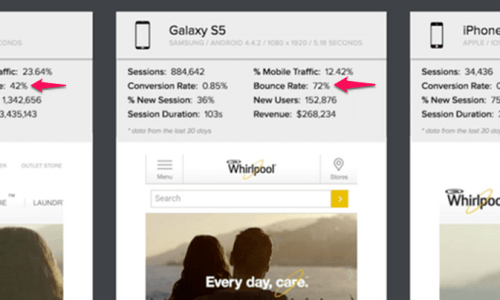Last Updated October 14, 2016
Mobile analytics, like a precious compass in the hands of a seasoned sailor, allow you to locate where you are in the choppy seas, fix a direction and set your sights on your destination.
Here are just a few of the critical ways in which mobile metrics can steer you towards your true north: increasing conversion on mobile devices.
Your starting point: the baseline
In its simplest form, mobile analytics – that is, an array of numbers measuring performance for mobile devices – allow you to establish a clear baseline of present-day accomplishments. Only with a firm baseline can you assess the impact of any change you make to your website and its display on mobile phones and tablets.
Identify key differences with device-level metrics

Device-level analytics, that is, metrics showing your website’s performance on each model of tablet or phone, enable you to quickly spot critical differences in performance.
Are there significant differences in key measures on one mobile device compared to another (or on all mobile devices compared to website desktop metrics)? Is your site underperforming or over-performing when viewed on Samsung’s latest S6 Edge? What about when rendered on the Kindle Fire HDX 7?
Any deviating statistic should be seized on and leveraged. Armed with data on your bounce rate, load time, conversion rate, etc., you can explore what’s working and what’s not.
When you identify differences in metrics among mobile devices, start forming hypotheses on what accounts for the differences. A close visual inspection of your website’s appearance on mobile devices can help identify key variables for future testing. Especially useful are mobile testing tools that allow side by side comparison, and deliver device-level data alongside visual renderings of the mobile phone or tablet.
Device-level analytics, thus, help suggest important factors for A/B testing and also deliver the capacity to determine the winners and losers in such tests. Once you’ve tested and proven factors that promote engagement and conversion on individual mobile devices, you have three basic options:
- Fix the flaws in a particular mobile device’s display via the user agent to elevate its performance.
- Roll out site improvements across all mobile devices (and desktop computers too).
- Bring in a website consulting agency, such as Mobile1st, that specializes in mobile optimization.
BTW, be sure to pay attention to how much traffic and revenue is coming from each mobile device. Once you know those numbers, you can devote the most attention and optimization to your richest potential revenue streams.
Fix that mobile glitch!

Of course, a mobile device that significantly underperforms may be simply providing a deficient experience to site visitors. Direct testing and visual inspection of your website’s performance on actual mobile devices hosted in an online testing lab such as Mobilizer can help you spot those errors.
Unfortunately, major brands’ websites still display jarring defects when appearing on mobile phones and tablets. Errors like chopped text, cropped pictures, wayward colors, missing videos, and words too small to decipher can threaten sales conversions and even your brand’s reputation. Thoroughly check your site to ensure a trouble-free mobile user experience.
Mobilizing the numbers: Key individual metrics
- Slow load times
Load time – the number of seconds it takes for your web page to properly display – is a critical measurement. Surveys reveal fully 42% of shoppers are unhappy with lengthy load times and declare it impedes their online shopping. In essence, speed (or its lack) kills conversions on mobile devices, just as on desktops.
How fast does a page’s display need to be? According to KissMetrics, 47% of shoppers expect a web page to load within two seconds.1 Over four seconds, you risk serious customer dissatisfaction and bounce.
Shockingly, Trilibis tells us that 31% of sites actually take from 8 to 48 seconds to load. In contrast, Google developers aim for a load time under one second. Mobile devices typically load slower than desktops. Check your mobile load times with device-level metrics to see if you deliver under four seconds. Images are frequently the main culprit for exaggerated page weight and slow load time.
- Bounce rate (and session duration)
Bounce rate is the percentage of visitors to your website that depart after viewing only a single page (their landing page.) A high bounce rate sounds bad, but is it? As with all metrics, what is an acceptable bounce rate depends upon the particular audience and goals of your website
Bounce rate, along with time spent on your site (session duration), is a measure of your users’ engagement with the website. Visitor engagement in addition to easy site usability can lead the potential buyer from one relevant page to the next until achieving the final sales conversion.
An elevated bounce or exit rates may indicate a poor alignment between your website and the expectations of its traffic. The content on the page is failing to satisfy visitors. But is the problem the content or the visitors? Are the sources directing traffic to your site bringing the wrong sort of visitors? Are you targeting the wrong keywords, using the wrong marketing channels or failing to fulfill the promise of your ad copy? On the other hand, your website could be simply presenting its information poorly. Your site needs to clearly and persuasively guide your visitor to the next desired action, otherwise known as an effective call to action.
So what should be the ideal bounce rate? A bounce rate of 30 to 45% is better than average, says the folks at RocketFuel.2 Higher than average rates may set off alarm bells, but the ideal rate depends on the purposes of the website. Better to establish your current baseline and upgrade your bounce rate then to worry about comparisons. Mobile bounce rates are 10 to 20% higher, reflecting the average users’ very goal-directed behavior and need for speed.
- Conversion Rate
In the end, it all boils down to conversions. By conversion, I mean that much-desired magical transformation of a website visitor into a customer, a subscriber, a follower, a donor or whatever is the new desire status spelled out by your call to action.
Here’s an essential truth: most websites convert a very small percentage of the visitors. Monetate reports that conversion rates for desktops in Q1 2015 were a mere 2.94% in the United States, while mobile phones converted at an even smaller 1.08%.3 Therefore it’s critical to determine who is converting and why and where they are coming from. Divide and conquer should be your motto – segmenting your traffic is the best tactic for maximizing your results.
Investigate the characteristics of your website visitors and create a profile of those segments that convert. Here are key questions from MarketResearch4:
- From where do your converted visitors tend to come?
- How do converted visitors enter the website?
- Do visitors from a specific search engine or advertisement return to the website?
- What sources seem to drive the most interest in your website (referring URLs and acquisition strategies – DM, PPC, SEO, affiliates)?
Once you’ve segmented, classified and assessed the potential lifetime value of your visitors, you can adjust your website and your advertising tactics to attract those most likely to convert, while cutting spending on those less likely to become customers.
The to-do list of the digital marketing master may seem like a never-ending Excel spreadsheet — elevating SEO, establishing the right media mix, selecting your priority Google AdWords. However, one task – leveraging your mobile analytics – needs to be on the list and is certain to pay off in immediate boosts to engagement and conversion, whether it’s the big purchase or simply signing up for your next educational webinar.
Are You Optimized for Mobile? Get in touch with us to see where you’ve got missed opportunities.
1 KissMetrics: https://blog.kissmetrics.com/loading-time/
2 RocketFuel http://www.gorocketfuel.com/the-rocket-blog/whats-the-average-bounce-rate-in-google-analytics/
3 Monetate http://content.monetate.com/h/i/95458575-ecommerce-quarterly-q1-2015/173815
4 MarketResearch http://marketresearch.about.com/od/market.research.metrics/f/What-Is-A-Conversion-Rate.htm
- Google’s AMP: Enemy or Ally to Your Mobile Friendly Website? - January 29, 2018
- Mobile Marketing: Optimize the Mobile Customer Journey - January 29, 2018
- Mobile Load Time: Increasing Mobile Page Speed to Improve Mobile Conversion - January 22, 2018
